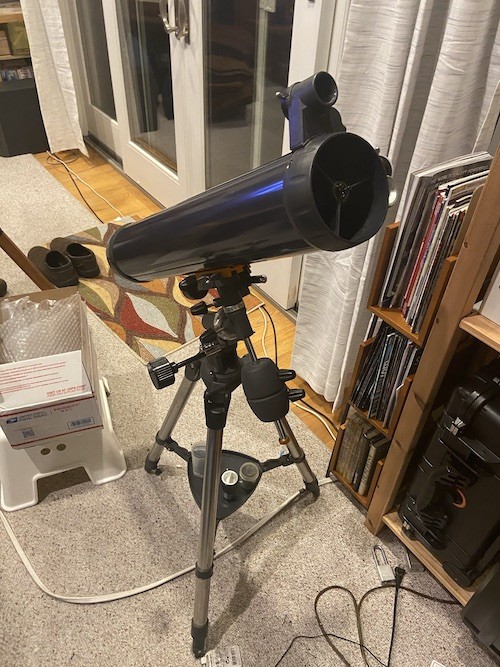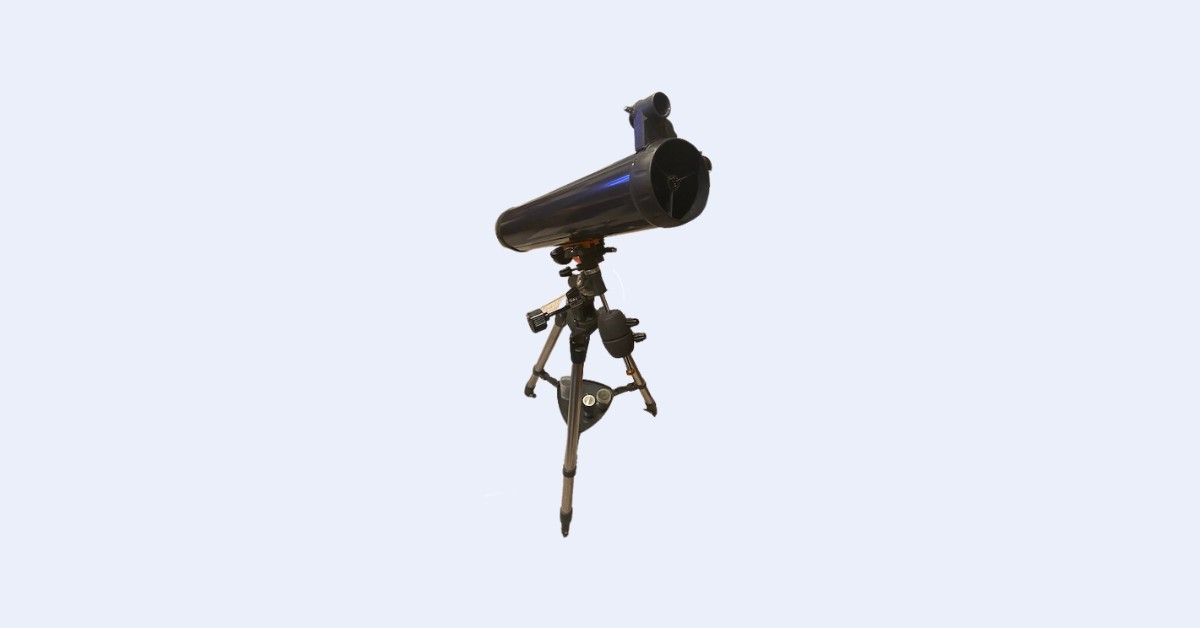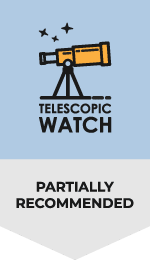Overview Of Astromaster 76EQ Optical Tube Assembly

The Celestron AstroMaster 76 optical tube is a 76mm (3-inch) f/9.2 Newtonian with a spherical primary mirror.
A 76mm f/9 sphere deviates only very slightly from a parabola, so it works just fine. This is not the case with larger, faster telescopes such as the 130mm f/5 Celestron AstroMaster 130 EQ, where a significant lack of sharpness and definition happens, which makes the telescope almost unsuitable for astronomical purposes.
The only optical drawback I’ve noticed with the AstroMaster 76 is its diminutive size. By the time we account for light loss from the mirrors and the secondary mirror’s obstruction, the Celestron AstroMaster 76EQ newtonian reflector performs only as well as a 60mm refractor.
However, the 76EQ does offer some advantages to us over a similarly-priced 60mm refractor:
- There is no chromatic aberration on reflector, giving it better planetary and lunar performance, all other things being equal.
- Shorter focal length on reflector, which gives reflector a wider field of view and lower power with a given eyepiece.
The Celestron AstroMaster 76 EQ reflector telescope has a decent red dot finder mounted to the front of the optical tube assembly and a more than adequate 1.25” rack and pinion focuser.
Both the primary and secondary mirrors can be collimated. This is a feature that, although required, somehow isn’t always available with most of the cheap small Newtonians that I’ve reviewed.
An annoyance I’ve encountered with the AstroMaster 76EQ is the focuser drawtube unnecessarily poking into the light path when it is racked all the way in.
Usually, while a telescope is being used, it’s racked out enough for this to not be a problem. But with some eyepieces that I had in my kitty, the focuser eclipsed the incoming light from hitting the scope’s primary mirror by quite a bit. Since this was bothering me, I removed the drawtube (which is quite easy), chopped the offending portion off with a hacksaw, and reinstalled it with absolutely no negative impact on the telescope’s functionality.
The other fault of the optical tube is that it has an extremely short dovetail bolted directly to the tube. There is thus no way for me to rotate the tube to a more comfortable position or balance it when I’m using heavy eyepieces or accessories.
Mixed Feelings on Eyepieces Provided
Like all other AstroMaster Newtonians, the Celestron AstroMaster 76 EQ comes with a cheap, narrow-field 20mm eyepiece. I would recommend replacing it with a 32mm or 25mm Plossl as soon as possible to get the most out of this telescope.
This 20mm eyepiece provides me with too much power (35x) to be a “low-power” eyepiece for a 76mm telescope. It also has a narrow, straw-like field of view. Furthermore, its useless erecting optics and cheap coatings absorb a lot of light and degrade the image quality.
The other included eyepiece is a 10mm Kellner, which provides 70x. It’s a pretty decent eyepiece, I’d say, from what I’ve experienced, albeit largely made of plastic.
The Rock-Solid CG-3 Mount
The mount supplied with the AstroMaster 76EQ is referred to in some literature as the “CG-2,” but it is identical to the mount supplied with the larger AstroMasters, which Celestron terms the CG-3.
If you ask me, the CG-3 is an overkill for the featherweight 76mm Newtonian optical tube. But it certainly does a great job. The scope is rock-solid, and I have zero complaints about its stability.
The CG-3 has flexible slow-motion cables. However, there is only one for the right ascension axis. I have to swap it from one side of the mount to the other, depending on which half of the sky I’m viewing.
The mount is also, of course, capable of taking other telescope optical tubes. But a different optical tube would likely cost more than the entire Celestron AstroMaster 76EQ unit.
The CG-3 can be motorized with Celestron’s Logic Drive for hands-free tracking.
Forget astrophotography, though. Any kind of camera will make the scope top-heavy and there’s no way to balance it, in addition to the fact that this is an f/10 scope on a relatively simple mount with only a partially metal focuser.
Alternative Recommendations
For the same price as or a little more than that of the Celestron AstroMaster 76EQ, I’d probably recommend a tabletop scope: either the Zhumell Z100 or the Orion SkyScanner, essentially identical scopes with a bit more aperture and far superior accessories. If you can expand your budget, the Zhumell Z114 is even better.
For additional options that might be right for you, check out our rankings and Best Telescopes article.
Aftermarket Accessory Recommendations
The only accessory that the AstroMaster 76EQ really needs is a 25mm Plossl eyepiece (28x). This will work far better as a low-magnification eyepiece than the included 20mm erecting eyepiece. A 2x barlow to bring the 10mm eyepiece up to 140x might also be a good idea.
Astrophotography Capabilities
Apart from simple phone shots, forget any kind of astrophotography with the Celestron AstroMaster 76EQ.
The scope is too small in aperture to do useful work with a CCD camera for planetary imaging (a CCD would also cost more than the entire telescope). A DSLR will strain the focuser and mount, as well as render the telescope unable to balance properly.
For a sub-$200 telescope, though, this is all to be expected.
What can you see with the Celestron AstroMaster 76EQ?
The 76mm aperture of the Celestron AstroMaster 76EQ telescope is only enough to show me the brightest deep-sky objects, but it will do a reasonably good job of observing the Moon and planets. With the AstroMaster 76EQ, I’ve seen:
- Mercury’s phases, with effort and luck
- Venus’ phases
- Lots of details on the moon
- One or two dark patches on Mars when it’s at opposition every two years.
- Jupiter’s moons, cloud belts, and Great Red Spot
- Saturn’s rings, its moon Titan, and maybe the Cassini Division and some banding on the planet itself with good seeing.
- Uranus and Neptune as turquoise and azure dots
- The Orion Nebula, the Ring Nebula, M13, the Pleiades, and a couple dozen of the other brightest deep-sky objects.
- Many double stars.




What price was this 76eq reviewed at? Just bought one for £99 and wondered if it is still good at that price. Thank you.
I think in the US it goes for slightly less than that if you convert the currency. Not a great buy at anything above 100 bucks, but it works…..
Hello, thank you for the great reviews. So I see you have a review of the Astromaster 76EQ… I don’t see a review of the Astromaster LT 76AZ, and very little information on it online, although it seems like it would be a decent starter telescope. They both share a lot of the same specs, except the LT 76AZ (Item #: 31036) has a Newtonian Reflector and a manual altazimuth mount. Would you consider both of these to be about the same, then, review-wise? Thank you again!
The 76AZ comes on a far worse mount – the EQ mount is a little more difficult to learn to use but is overall much higher quality and steadier.
Do not get the 76AZ.
Only because of the mount? Or anything else about it make it a better choice? I thought I read that the newtonian reflector was a better choice. Sorry for asking too many questions. I had already purchased the 76AZ for my spouse as a birthday gift this coming week, so trying to figure out whether to exchange it lol. Thanks again.